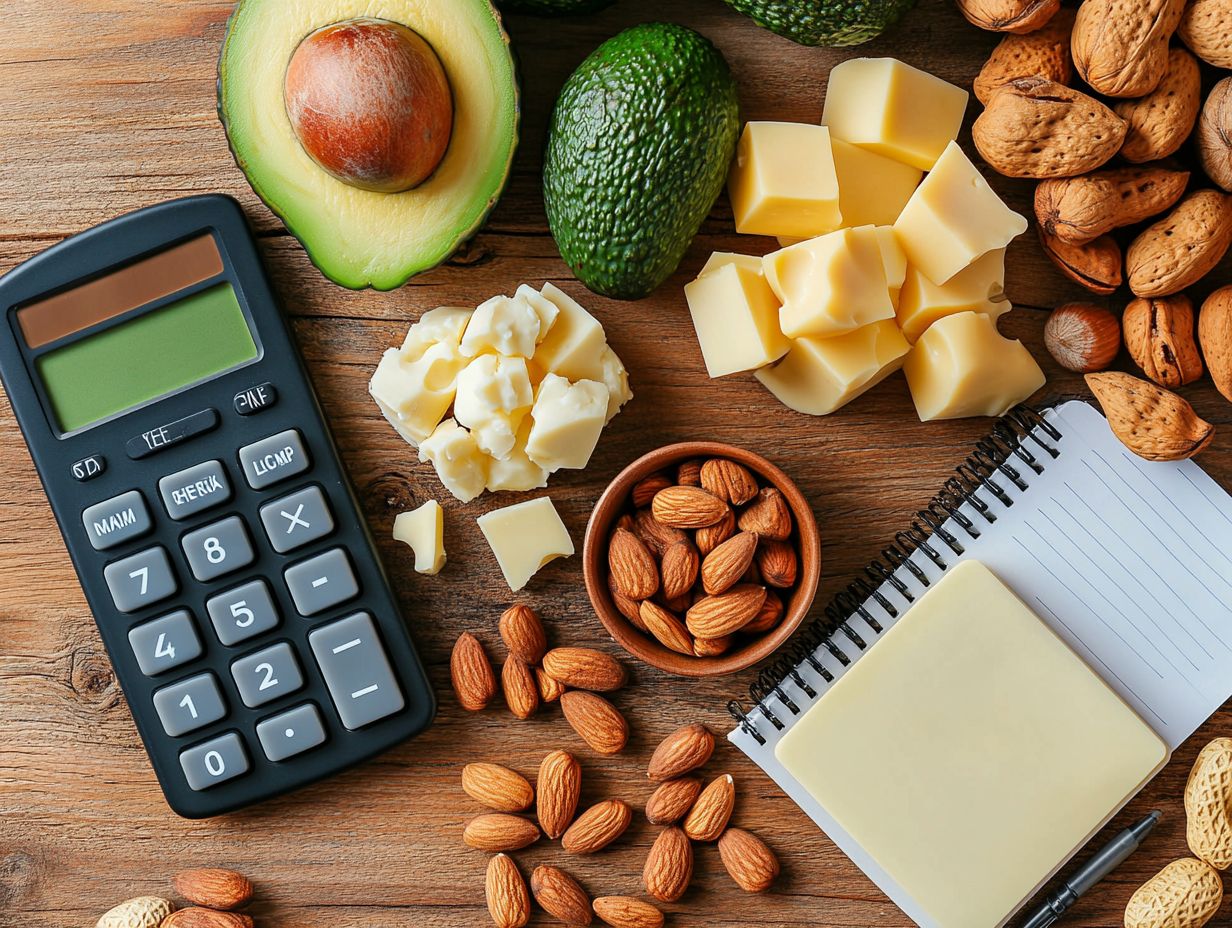How to Calculate Your Keto Macros
Embarking on a ketogenic diet can be an exhilarating journey toward improved health. Grasping the intricacies of keto macros and the macronutrient content in your meals is essential for your success.
Macronutrients proteins, fats, and carbohydrates significantly influence how your body adapts to this low-carb lifestyle.
This article delves into the fundamental aspects of keto macros, highlighting their importance and providing guidance on how to calculate your ideal ratios. You will find valuable tips on tracking your intake and steering clear of common pitfalls, all designed to help you achieve your weight loss or maintenance goals, including calorie tracking and carb tracking strategies.
Contents
- Key Takeaways:
- What Are Keto Macros?
- Why Are Keto Macros Important?
- How to Calculate Your Keto Macros?
- Step 1: Determine Your Daily Caloric Needs
- Step 2: Calculate Your Ideal Protein Intake
- Step 3: Determine Your Fat Intake
- Step 4: Calculate Your Net Carbs
- How to Track Your Keto Macros?
- Adjusting Your Keto Macros for Weight Loss or Maintenance
- Common Mistakes to Avoid When Calculating Keto Macros
- Frequently Asked Questions
Key Takeaways:

- Understanding keto macros is essential for a successful and sustainable ketogenic diet.
- Calculating keto macros involves determining caloric needs, ideal protein intake, fat intake, and net carbs.
- Tracking food intake accurately and adjusting macros as needed are crucial for achieving weight loss or maintenance goals.
What Are Keto Macros?
Keto macros are a vital aspect of the ketogenic diet, representing the precise ratios of macronutrients carbohydrates, proteins, and fats that you need to consume to enter and sustain a state of nutritional ketosis (the state when your body burns fat for fuel). Achieving this balance is vital for hitting your dietary goals, whether they involve weight loss, weight maintenance, or even weight gain.
Grasping these macronutrients is essential for anyone aiming to lose weight, manage body fat percentage, or enhance the overall health benefits linked to a high-fat, low-carb dietary approach. Understanding how to balance these components effectively, including your carb intake and protein needs, can be the key to unlocking your dietary goals.
What Are the Macronutrients in Keto?
In a ketogenic diet, the macronutrients you focus on are high fat, moderate protein, and very low carbohydrates, each playing a crucial role in achieving and maintaining nutritional ketosis. This unique macronutrient composition is crafted to shift your body s primary energy source from glucose to ketones, effectively transforming fat into fuel. This shift can help improve metabolic state and energy consumption, making it easier to achieve your goals.
Typically, an ideal keto macronutrient breakdown hovers around 70-75% of calories from fat, 20-25% from protein, and a mere 5-10% from carbohydrates. By limiting your carbohydrate intake, you effectively reduce insulin levels, which promotes fat oxidation and encourages weight loss. A moderate protein intake is essential as well, helping to preserve muscle mass during your weight loss journey and ensuring that fat loss takes precedence.
When you adhere to these ratios, you can significantly enhance your energy levels and support optimal health. This approach allows you to experience not just a physical transformation but also a newfound mental clarity.
Why Are Keto Macros Important?
Grasping the significance of keto macros is crucial for anyone embarking on a ketogenic diet. When you properly balance your macronutrients, you can profoundly influence your weight loss journey, improve body composition, and unlock a host of overall health benefits, including better appetite control and metabolic state regulation.
By promoting a calorie deficit and enhancing appetite control, you can create a favorable metabolic state that supports your goals. This can be particularly useful when managing conditions like Type 2 Diabetes, where blood sugar levels need to be carefully controlled.
How to Calculate Your Keto Macros?
Calculating your keto macros is an essential step in successfully navigating the ketogenic diet. By determining your daily caloric needs with methods like the Mifflin-St. Jeor Formula or utilizing a keto calculator, you can establish your ideal macronutrient ratios. This precision is key for achieving optimal weight loss and maintaining your results.
In summary, understanding keto macros is vital for your ketogenic journey. Knowing how to calculate and adjust your ratios can lead to significant improvements in your health and weight loss goals. Take the first step into the ketogenic diet journey by mastering your macros!
Step 1: Determine Your Daily Caloric Needs
Determining your daily caloric needs, also known as total daily calories you burn, is your first step toward calculating your keto macros. You can achieve this through various formulas, such as the Mifflin-St. Jeor Formula, Harris-Benedict Formula, or Katch-McCardle Formula. These formulas consider your activity level and personal metrics.
To apply these formulas effectively, it’s essential to look at individual factors like age, gender, body composition, and lifestyle choices. For instance, a young athlete’s caloric requirements will differ greatly from those of a sedentary older adult. Picture a 30-year-old male bodybuilder compared to a 50-year-old female office worker; the bodybuilder’s caloric needs will be significantly higher due to his muscle mass and energy expenditure during workouts.
By carefully inputting these variables into your chosen formula, you’ll see how vital it is to customize your nutritional planning based on your unique attributes. This approach ensures that you can achieve your health and weight loss goals sustainably and effectively. Consulting a healthcare provider for personalized advice can also be beneficial.
Step 2: Calculate Your Ideal Protein Intake

Calculating your ideal protein intake is crucial in the ketogenic diet, typically suggested to be around 20-25% of your total daily calories. This means your ideal protein intake can change based on how much muscle you have and your overall protein requirements. High protein intake is often recommended to support muscle recovery and growth.
To determine the appropriate protein levels for yourself, start by calculating your lean body mass (the weight of your body minus fat). You can use various online tools or formulas that consider your height and weight. Once you have this baseline figured out, consider your activity level. If you engage in regular high-intensity exercise, you may need a higher protein intake to support muscle recovery and growth.
Your personal fitness goals also play a significant role in this calculation. If you’re looking to build muscle, your protein needs will differ from someone whose focus is weight loss. Using calculators that factor in these variables can simplify this process, guiding you toward your ideal protein intake with precision.
Step 3: Determine Your Fat Intake
Determining your fat intake is crucial in the keto diet, as fats should make up the majority of your caloric consumption typically around 70-75%. This ensures you re properly energized and maintaining that coveted high-fat metabolic state. Understanding your fat needs helps you tailor your diet effectively.
To calculate your fat intake, start by assessing your total daily calorie needs based on factors like your age, activity level, and weight goals. For example, if your daily caloric requirement is 2000 calories, you should aim for approximately 1400 to 1500 calories from fats. Considering that each gram of fat contains about 9 calories, this translates to around 155 to 167 grams of fat per day. Using tools like DEXA scans can help assess your body composition accurately.
Don’t forget about protein, which is essential for muscle maintenance. A balanced intake of around 20-25% of your total calories from high-quality protein sources can significantly enhance your results. Aligning these macronutrient ratios promotes optimal fat oxidation, enabling you to fully embrace the benefits of the ketogenic lifestyle and avoid a weight loss plateau. Don t miss out on the benefits; proper fat intake keeps you energized and helps you achieve your weight loss goals!
Step 4: Calculate Your Net Carbs
Calculating your net carbs is essential when following the ketogenic diet, which typically restricts carbohydrate intake to about 5-10% of your total daily calories. This calculation includes factoring in dietary fiber to ensure you stay below the ketosis threshold. Understanding your carbohydrate tolerance is key to maintaining ketosis.
To accurately determine your net carbs, simply subtract the dietary fiber content from the total carbohydrates listed on food labels. Since fiber isn t digested and doesn t affect blood sugar levels, it s a crucial part of the equation. For example, if you encounter a food item with 10 grams of total carbohydrates and 6 grams of dietary fiber, the net carbs would amount to 4 grams.
This calculation is vital because it enables you to monitor your carbohydrate consumption effectively, supporting both the maintenance of ketosis and your energy levels.
Grasping this concept can significantly enhance your ability to select appropriate foods while navigating the intricacies of a keto lifestyle.
How to Track Your Keto Macros?
Tracking your keto macros is crucial for maintaining your targeted macronutrient ratios and ensuring you stay on the path to weight loss or maintenance. Leveraging practices like calorie tracking and custom input into tracking tools can make this process smoother.
By utilizing tools like a keto calculator, a food diary, or specialized tracking apps such as MyFitnessPal or Cronometer, you can simplify the process and make your journey more enjoyable. These tools help you keep track of your macronutrient breakdown and ensure you stay on track with your dietary goals.
1. Use a Keto Macro Calculator
Utilizing a keto macro calculator is one of the most straightforward and effective methods for determining your daily macronutrient targets, specifically tailored to your unique goals and calorie requirements. Craig Clarke, a notable keto expert, also recommends using these calculators for accurate results.
By entering personal details such as your age, weight, height, activity level, and specific objectives be it weight loss or muscle gain you will receive a customized breakdown of carbohydrates, proteins, and fats to follow for optimal results. Understanding how these macronutrient ratios interact with the ketogenic lifestyle is essential for maintaining ketosis while effectively fueling your body.
Once the calculator generates these figures, interpreting the results is key. Tracking your daily intake against these calculated targets allows for necessary adjustments and keeps your motivation high. Sticking to these guidelines will boost your overall success on the ketogenic journey. Incorporate keto-friendly foods and recipes to make it easier to stay consistent.
2. Track Your Food Intake with a Food Diary
Keeping a food diary is another effective method for tracking your macronutrient intake, enabling you to maintain your keto diet success. By meticulously logging everything you eat and drink, you can ensure your macronutrient ratios align with your dietary goals.
By documenting each meal, snack, and drink, you can uncover insights into your eating patterns and pinpoint areas that may need improvement. This practice not only fosters mindfulness regarding your food choices but also enhances calorie tracking and carb tracking, ensuring your daily intake aligns seamlessly with your personal health goals.
Regarding managing your diary effectively, you have options. Whether you opt for sleek apps or stick with a classic notebook, categorizing your meals by time and type can elevate your tracking game. Including details such as portion sizes, macronutrient content, and your feelings about food can deepen your understanding of your eating habits, ultimately enabling you to make more informed decisions.
3. Use a Tracking App or Website

Utilizing a tracking app or website like MyFitnessPal or Cronometer can greatly simplify the process of monitoring your keto macros. This ensures you stay on track to meet your dietary goals. These apps often include tools like a keto calculator to help you manage your diet more effectively.
These tools not only allow you to log your food intake effortlessly, but they also come with features that help calculate your daily calorie limits, total daily energy expenditure (TDEE), and macro ratios. For optimal effectiveness, take full advantage of the barcode scanner feature to quickly input items, along with the vast food database that typically includes everything from restaurant offerings to homemade recipes.
Setting up personalized goals based on your individual weight loss or maintenance targets can significantly enhance tracking accuracy. To truly maximize their utility, make it a habit to log your meals immediately after eating, ensuring that nothing goes unrecorded. Monitoring net carbs is also crucial for maintaining the state where your body uses fat for energy instead of carbohydrates.
Consistent use of these apps can reveal insightful trends. This aids you in making dietary adjustments that align seamlessly with your overall health objectives and body composition goals.
Adjusting Your Keto Macros for Weight Loss or Maintenance
Adjusting your keto macros allows you to create a calorie deficit or extra calories based on your weight loss or maintenance goals.
This personalized approach ensures that you re not only on track but also optimizing your results.
1. Decrease Your Calorie Intake
Decreasing your calorie intake is one of the most effective strategies for achieving weight loss on the keto diet. It requires a keen eye on your macronutrient ratios to maintain the state where your body uses fat for energy instead of carbohydrates.
You can use methods like the Mifflin-St. Jeor Formula or Harris-Benedict Formula to help calculate your daily calorie needs to achieve weight loss. As you reduce your calorie consumption, it s vital to ensure that your body still receives adequate nutrients, particularly from healthy fats, proteins, and a limited amount of carbohydrates.
This approach not only promotes weight loss but also influences your energy levels and overall well-being. Tracking your fiber intake is also crucial to maintaining good digestive health.
To fine-tune your macronutrients, aim for a higher percentage of fats while ensuring your protein intake is sufficient to prevent muscle loss. Maintaining a balanced diet during this process is essential, as it supports your sustained health and prevents nutrient deficiencies and blood sugar levels from spiking. This ultimately makes your keto journey more effective and enjoyable.
2. Adjusting Your Macronutrient Ratio
Adjusting your macronutrient ratio can profoundly impact your weight loss journey on the keto diet, so it’s essential to carefully consider your protein and fat intake to align with your goals.
When you aim for optimal results, finding the right balance between these macronutrients is crucial. This involves being mindful of the percentage of daily calories you derive from fats, proteins, and carbohydrates.
For example, while a typical ketogenic diet emphasizes high fat intake, it s vital not to overlook protein needs, as it plays an essential role in preserving muscle. This, in turn, can enhance your metabolic rate and facilitate fat loss.
You might find it beneficial to experiment with different ratios, starting with a common distribution of 70% fat, 25% protein, and 5% carbs. Then adjust based on your body s unique response. Incorporating nutrient-dense foods like avocados, eggs, and leafy greens can also bolster your health without compromising your diet’s objectives.
Using DEXA scans (a method to measure body composition) can help you better understand your body composition and adjust your macros accordingly.
Common Mistakes to Avoid When Calculating Keto Macros
Avoid these common pitfalls to supercharge your success on the ketogenic diet! When calculating your keto macros, it’s crucial to sidestep missteps that can hinder your progress. Overlooking your unique needs or failing to track your intake accurately can derail your efforts and lead to unnecessary frustration.
Prioritizing precision in your approach will enable you to stay on track and achieve your goals with confidence.
1. Not Considering Individual Needs and Goals
Overlooking your individual needs and goals when calculating keto macros is a common misstep that can significantly hinder your weight loss journey and nutritional balance. Consulting with a health care provider can provide personalized advice tailored to your unique needs.
As you embark on a ketogenic diet, it’s essential to understand that a one-size-fits-all approach simply won t cut it. The effectiveness of your keto macros depends on several factors, including your personal objectives be it fat loss, muscle gain, or maintenance. It also depends on your unique body composition and activity levels.
This is where tools like a keto calculator can be extremely useful. By customizing these calculations, you can align your dietary strategies with your lifestyle more effectively.
This personalized approach not only enhances your adherence to the diet but also creates a more dynamic and flexible meal plan tailored to meet your specific metabolic needs and energy expenditures. Consider using custom input options in tracking apps for more precise planning. In turn, this paves the way for sustainable health and wellness outcomes that truly resonate with you.
2. Not Tracking Accurately

Failing to track accurately is a prevalent mistake that can undermine the effectiveness of your keto diet, potentially leading you away from your macro goals and hindering your progress. Understanding your carbohydrate tolerance how many carbs your body can handle while staying in ketosis and net carbs becomes crucial.
This oversight can have significant repercussions, such as stalled weight loss and struggles with energy levels. To sidestep these pitfalls, it’s vital for you to adopt a meticulous approach to recording your food intake.
Utilizing a reliable app or food diary can greatly enhance your precision, while measuring portions with a food scale ensures that every bite aligns perfectly with those vital macronutrient ratios.
Remaining vigilant about hidden carbs in sauces or dressings can further support your adherence to dietary objectives. By prioritizing accuracy in tracking, you position yourself to achieve your desired outcomes, cultivating both confidence and motivation along your wellness journey.
3. Not Adjusting Macros as Needed
Not adjusting your macros as needed can lead to a frustrating weight loss plateau, hindering your pursuit of desired results on the keto diet. This happens because your body becomes accustomed to a specific caloric intake and the balance of fats, proteins, and carbs over time, which can stall your weight loss efforts. Consulting with experts like Craig Clarke can also provide tailored advice to help overcome such plateaus.
Regularly revisiting and fine-tuning your macro calculations based on your progress and personal body signals is essential. As you advance on your keto journey, your energy needs may fluctuate due to changes in metabolism, physical activity levels, muscle mass, and lean body mass.
Incorporating strategies such as meticulously tracking your food intake, being attentive to your hunger cues, and adjusting your protein, fat, and carbohydrate ratios can help you maintain continuous progress. Ultimately, adopting a flexible approach not only aids in overcoming plateaus but also cultivates a deeper understanding of your body s dynamics and metabolic state.
Signs You Need to Adjust Your Macros
Watch for signs like persistent fatigue, lack of weight loss, or increased cravings that may indicate it’s time to revisit your macro settings.
Frequently Asked Questions
What are keto macros and why are they important?
Keto macros, short for macronutrients, refer to the three main components of a keto diet: fat, protein, and carbohydrates. These macros are essential because they determine the ratio of nutrients you consume, which is crucial for achieving and maintaining ketosis.
Start tracking your intake today for better results on your keto journey!
How do I calculate my keto macros?
To calculate your keto macros, you first need to determine your daily calorie needs based on your gender, age, weight, and activity level. Next, allocate your daily calorie intake among the three macros in a specific ratio. On a standard keto diet, the ratio is typically 70-75% fat, 20-25% protein, and 5-10% carbohydrates.
Can I use an online calculator to calculate my keto macros?
Yes, there are various online keto macro calculators that can help you determine the right ratio for your macros based on your personal information. However, keep in mind that these calculators are only estimates and may not be accurate for everyone.
Do I need to track my keto macros every day?
Tracking your keto macros daily is highly recommended, especially if you’re new to the diet. This practice will help you stay within your desired macro ratio and ensure you’re consuming the right amounts of fat, protein, and carbs for your body’s needs.
How will my keto macros change if I have a different calorie goal?
Your macros will change depending on whether you aim for a calorie deficit for weight loss or a calorie surplus for weight gain. Adjusting your macros according to your total daily energy expenditure (TDEE) and daily calorie needs is essential.
If your calorie goal differs from the standard 2000 calories, your keto macro ratio will also change. For instance, a higher calorie goal will necessitate more fat, protein, and carbs to consume in a day, while a lower calorie goal or a calorie deficit will result in lower macro amounts.
Adjusting Keto Macros for Results
If you’re not seeing the desired results, you can adjust your keto macros to better fit your body’s needs. For weight loss, consider decreasing your fat intake and increasing your protein intake. Conversely, for weight gain or maintenance, increase your fat intake and decrease your protein intake.
Monitoring your body composition using DEXA scans and adjusting your macronutrient content, net carbs, and fiber intake is essential. A healthcare provider can help you determine your carbohydrate tolerance and blood sugar levels for better keto diet success.




